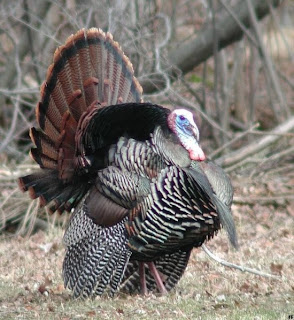Food preferences. The diet is more than 80 percent plant food, with 10 to 20 percent primarily insects. Young poults eat insects, berries and seeds, while adults will eat anything from acorns and berries to insects, salamanders, snails and small reptiles. Fruits of wild grape, dogwood and wild cherry are favorites.
Turkeys also eat numerous seeds, including those of native grasses, sedges, trees and ferns.
Water. A source of open water is necessary to support a wild turkey population. They drink from spring seeps, streams, ponds, lakes and livestock watering facilities. It’s critical to have water as well as foraging, nesting, brood rearing and roosting cover all available near each other to support populations.
Nesting cover. Eastern wild turkeys nest on the ground in hardwood or mixed forest, usually at the base of sizable trees in dense understory cover. They may also nest under a brush pile, in thickets or under downed trees and branches.
Preferred nest sites are near openings or on forest edges where newly hatched poults have access to insects after hatching.
Roosting cover. Wild turkeys roost overnight in trees to avoid predators. The exception is for hens with up to one-month old poults-- they roost on the ground in habitat similar to nesting habitat. Ideal roosting trees are mature, open crowned trees with branches spaced 18 inches apart that run parallel to the ground, with trunk diameters at least 14 inches, locating within a half mile of a food source.
Brood rearing cover. Wild turkeys like open areas of grass, forb and legume mixtures for feeding. A forest opening of a half to three acres is a good size - poults can eat insects but also see and hide from predators.
For more information, stop at our office at 9711 East Pike, Cambridge, 740-432-5624 or visit the National Wild Turkey Federation website.
Did you know....In the early 1930s the wild turkey was on the verge of extinction. But today, thanks to wildlife restoration programs and willing landowners, the wild turkey is abundant and thriving.It’s found in every state except Alaska.










